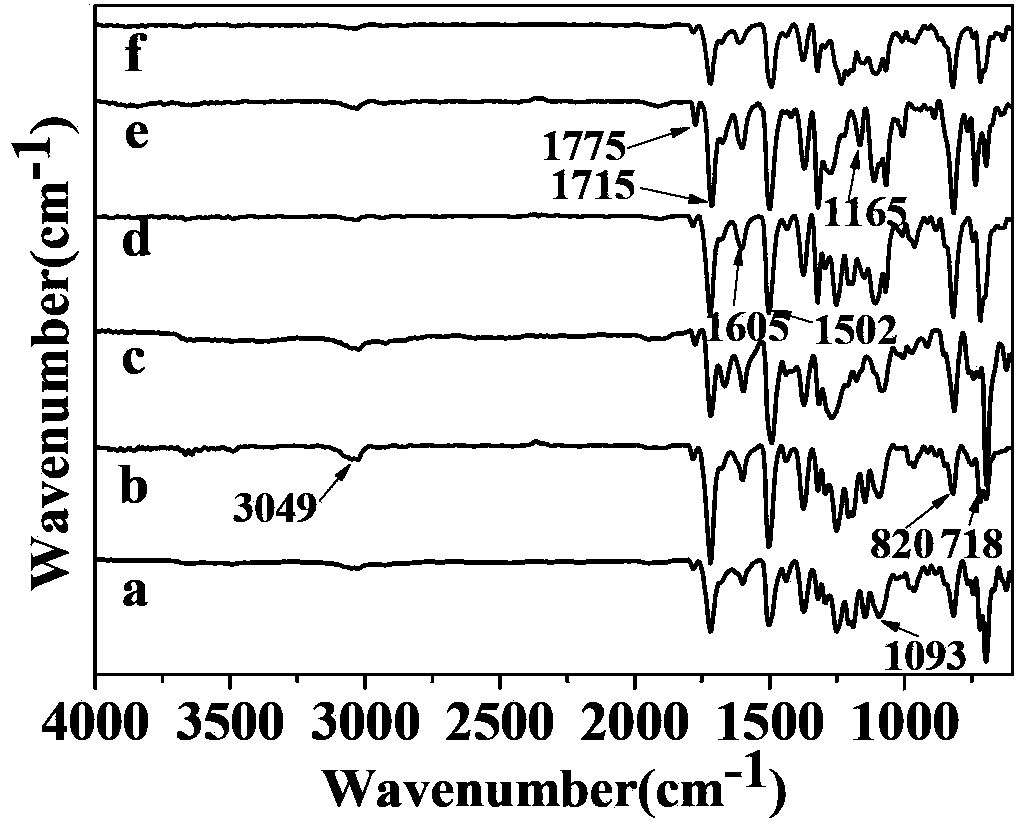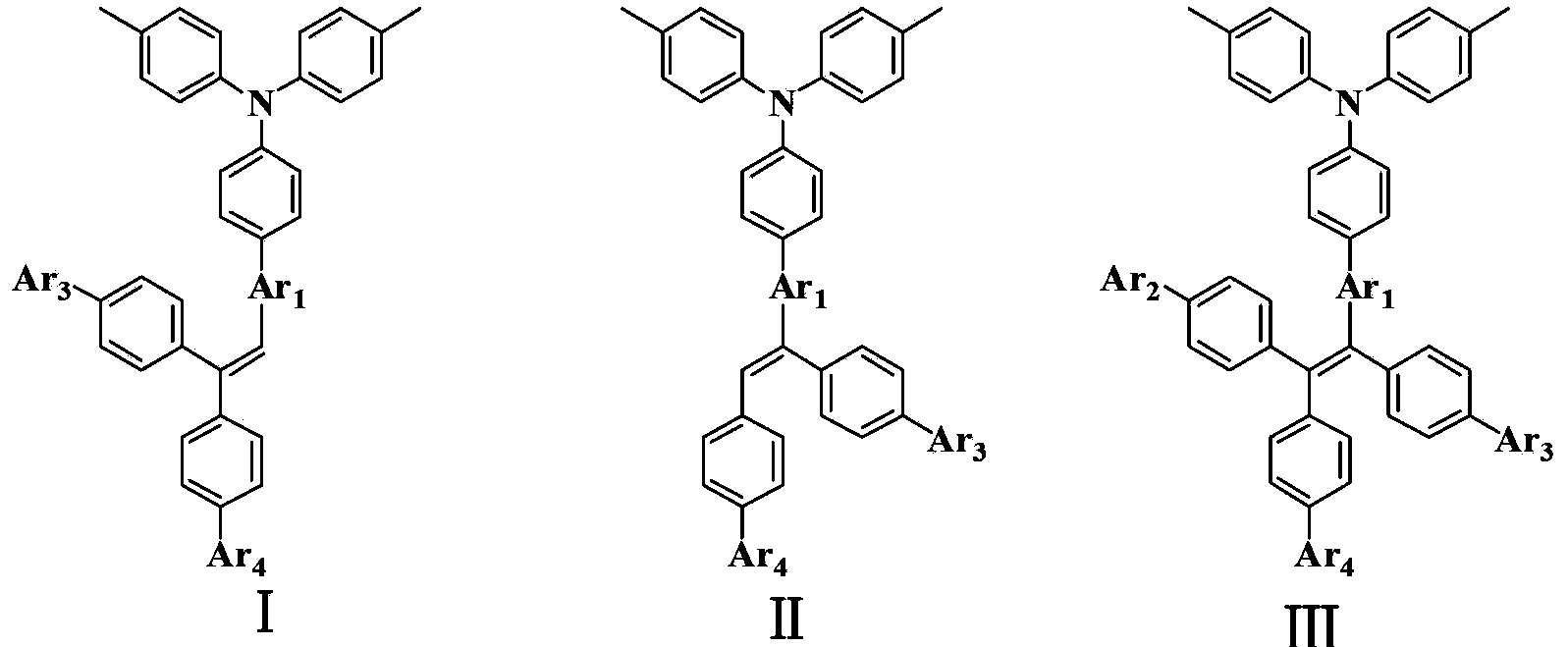Polyimide with low dielectric properties, and preparation method and application thereof
A polyimide, low-dielectric technology, applied in the field of material science, can solve the problems of difficult control of pore structure, difficulty in controlling the size of pore size, limited number of templates, etc., and achieve high glass transition temperature and thermal stability , The preparation process is simple and diverse, and the effect of excellent photoluminescence
- Summary
- Abstract
- Description
- Claims
- Application Information
AI Technical Summary
Problems solved by technology
Method used
Image
Examples
Embodiment 1
[0043] Use benzophenone to obtain Tri-Br by Wittig or Wittig-Horner reaction; then obtain TrP-NHi by one-step Suzuki reaction or by multi-step reaction 2 ; Then react with p-fluoronitrobenzene to obtain Tri-TPA-2NO 2 ; Final reduction to obtain Tri-TAP-2NH 2 .
[0044] At room temperature, 5.2967g (0.01mol) (Tri-TPA-2NH 2 ) and 64.9g (68.8ml) N,N-dimethylformamide were added to a 100ml three-necked flask, argon gas was introduced, stirred, and after completely dissolving, 4.4424g (0.01mol) 4,4-hexafluoroiso Propyl phthalic anhydride (6-FDA), continued stirring reaction 12h, obtains the homogeneous viscous polyamic acid solution. Scrape-coat the obtained polyamic acid solution on a clean glass plate, then place the glass plate in a vacuum oven and evacuate it. The heating program is: the room temperature is raised to 100°C and then the temperature is kept constant (the whole process is 1h) → 100°C is heated to 200°C After constant temperature (the whole process 1h) → 200 ℃ ...
Embodiment 2
[0048] At room temperature, 5.2967g (0.01mol) (TPA-TPE-2NH 2 ) and 64.9g (68.8ml) N,N-dimethylformamide were added to a 100ml three-necked flask, argon gas was introduced, stirred, and after completely dissolving, 4.4424g (0.01mol) 4,4-hexafluoroiso Propyl phthalic anhydride (6-FDA), continued stirring reaction 12h, obtains the thick polyamic acid solution of homogeneous phase, and its molecular weight is 32.6 * 10 4 , the molecular weight distribution is 2.08. Scrape-coat the obtained polyamic acid solution on a clean glass plate, then place the glass plate in a vacuum oven and evacuate it. The heating program is: the room temperature is raised to 100°C and then the temperature is kept constant (the whole process is 1h) → 100°C is heated to 200°C After constant temperature (the whole process 1h) → 200 ℃ to 300 ℃, then constant temperature (the whole process 1h), the polyimide film can be taken out after cooling. The dielectric constant of the polyimide film can reach 1.44, ...
Embodiment 3
[0052] Prepare polyamic acid solution in the same way as in Example 1, and then prepare polyimide by chemical imidization. The steps are as follows: add 5 mL of acetic anhydride to the obtained polyamic acid solution, continue stirring, and then slowly add 2.5 mL of three Ethylamine, and heated to 70°C, continued to stir for 6 hours, then scraped the solution onto a clean glass plate, then placed the glass plate in a vacuum oven, evacuated, and dried at 100°C for 12 hours, and the polyimide film could be taken out after cooling. The polyimide film has a dielectric constant of 1.58, a dielectric loss of 0.003, a 5% thermal weight loss temperature of 531°C, a glass transition temperature of 302°C, and a wavelength of 539nm for the strongest fluorescence peak. The pass rate was 87%, and the solubility test result and the infrared spectrogram of the polyimide film were the same as in Example 1.
PUM
| Property | Measurement | Unit |
|---|---|---|
| tensile strength | aaaaa | aaaaa |
| tensile strength | aaaaa | aaaaa |
| temperature | aaaaa | aaaaa |
Abstract
Description
Claims
Application Information
 Login to View More
Login to View More - R&D
- Intellectual Property
- Life Sciences
- Materials
- Tech Scout
- Unparalleled Data Quality
- Higher Quality Content
- 60% Fewer Hallucinations
Browse by: Latest US Patents, China's latest patents, Technical Efficacy Thesaurus, Application Domain, Technology Topic, Popular Technical Reports.
© 2025 PatSnap. All rights reserved.Legal|Privacy policy|Modern Slavery Act Transparency Statement|Sitemap|About US| Contact US: help@patsnap.com



